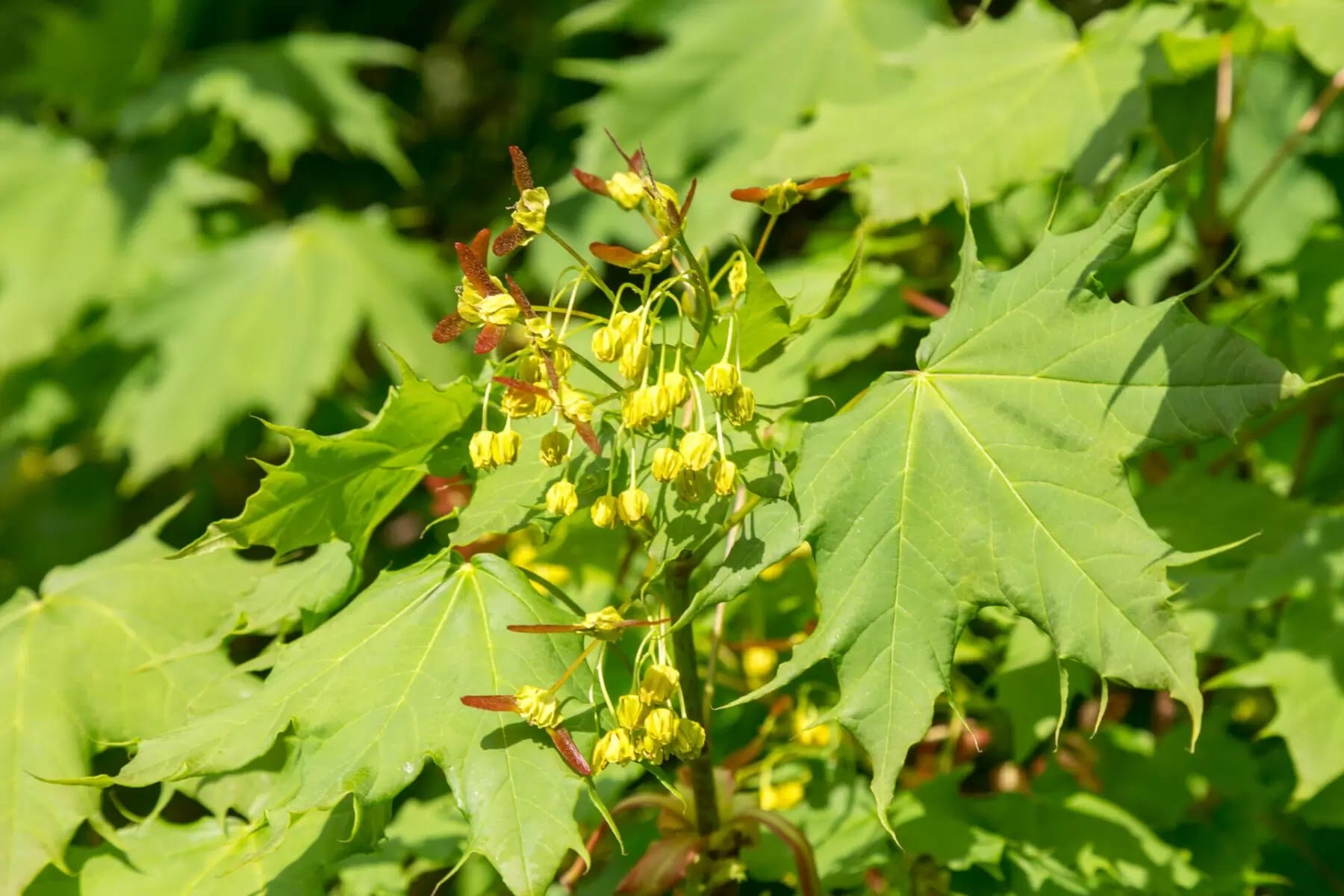Unveiling the Amur River Maple: A Small Tree with a Big Impact
The Amur River maple (Acer tataricum subsp. ginnala) is a small tree, sometimes growing as a large shrub, renowned for its vibrant fall foliage. Native to Northeast Asia, this adaptable tree has become a popular landscaping choice across North America, thriving in USDA hardiness zones 3-8. Its rapid growth and tolerance to various soil and light conditions make it an attractive option for gardeners. However, its prolific seed production and potential for invasiveness require careful consideration and management. Uncover the hidden gems of bentonite hills utah, a testament to nature’s diverse landscapes, as a point of comparison for unique natural features.
Amur River Maple: Balancing Beauty and Control
The Amur River maple’s appeal lies in its compact size, fast growth, and spectacular crimson fall display. Unlike larger maples, it fits well in smaller yards, reaching a typical height of 15-20 feet, with the potential to reach 30 feet under ideal conditions. However, this fast growth, fueled by abundant seed production, can lead to aggressive spreading. This poses a risk of the Amur maple becoming invasive, particularly in disturbed areas, outcompeting native species and potentially altering local ecosystems.
Managing Amur River Maple Growth
To prevent the Amur River maple from becoming a nuisance, regular monitoring is crucial. Diligent removal of seedlings is key. If the tree becomes highly invasive in your region, more drastic measures like cutting down mature trees or applying herbicides may be necessary. Always consult local experts before taking such actions.
Amur River Maple vs. Other Maples: A Comparative Look
Compared to its maple cousins, the Amur River maple stands out due to its:
- Compact Size: Ideal for smaller spaces, unlike larger maples like the Red Maple.
- Rapid Growth: Establishes quickly, unlike the slower-growing Japanese Maple.
- Vibrant Fall Color: A brilliant crimson display, often surpassing the red to orange hues of other maples.
| Feature | Amur River Maple | Japanese Maple | Red Maple |
|---|---|---|---|
| Size | Small to Medium | Small to Medium | Large |
| Growth Rate | Fast | Slow to Medium | Medium |
| Fall Color | Vibrant Crimson | Variety of Reds | Red to Orange |
Understanding the Ecological Impact of Amur River Maple
The Amur River maple’s invasive potential isn’t merely a gardening issue. Its rapid spread can negatively affect biodiversity by displacing native plant species, thus altering ecosystems and impacting wildlife that depend on those plants. The formation of dense thickets further exacerbates this issue, shading out native understory and creating monocultures. Research suggests that this impact varies regionally, requiring tailored management approaches.
Strategies for Sustainable Management
Ongoing research explores several strategies to manage the Amur River maple’s spread sustainably, including biological control methods (introducing specific insects), prescribed burns, and promoting the growth of competitive native plants. A combination of these approaches will likely prove most effective.
Regional Variations in Amur River Maple
The Amur River maple’s behavior isn’t uniform across its range. Factors like growth rate, cold tolerance, and even fall color intensity can vary depending on the region. This suggests that effective management strategies may need to be location-specific. Continued research is essential to understand these regional differences fully and develop the best management practices.
The Disadvantages of Amur Maple: Weighing the Risks
While the Amur maple boasts undeniable beauty and resilience, its invasive tendencies present significant challenges. Its aggressive growth, fueled by prolific seed production, can quickly transform it from an attractive ornamental to a disruptive force in your garden and the surrounding ecosystem. This prolific seeding and adaptable nature contribute significantly to its invasive potential, especially in regions like the Northeast and Midwest United States. Its seeds germinate readily, even in shaded conditions, further accelerating its spread.
The resulting dense thickets not only shade out native plants, hogging essential resources like sunlight, water, and nutrients, but also contribute to reduced biodiversity. This creates a less resilient local ecosystem and can have a ripple effect on local wildlife, including insects and birds that rely on native flora. Unlike many other small to medium ornamental trees, managing Amur River Maple seedlings due to their mature root systems requires significant intervention as suggested by The Spruce.
Furthermore, eradicating established Amur maples can be a daunting task. Their extensive root systems make complete removal difficult, demanding constant vigilance and effort. While herbicides offer a potential solution, their use requires careful consideration due to potential harm to non-target species and the broader ecosystem.
Amur Maple Size and Growth: Understanding Its Potential
Amur maples typically reach 15-20 feet in height, roughly the size of a two-story house. Under optimal conditions, they can reach up to 30 feet, comparable to a three-story building. This remarkable growth is achieved through a rapid annual growth rate of 2-3 feet, allowing them to reach near maximum height within approximately ten years. However, actual growth can vary depending on environmental factors like soil nutrients, competition from other plants, and local climate. Ongoing research suggests that different cultivars may also exhibit variations in growth patterns.
| Feature | Typical Range | Potential Maximum |
|---|---|---|
| Height | 15-20 feet | 30 feet |
| Annual Growth | 2-3 feet | Varies |
| Time to Maturity | Approximately 10 years | Varies |
Understanding these growth patterns is crucial for effective landscaping. Consider whether a potentially 30-foot tree will suit your space before planting.
Decoding the Names of Amur Maple: From Common to Scientific
The Amur maple is most commonly known as just that – Amur maple. Its scientific name, Acer ginnala (or sometimes Acer tataricum subsp. ginnala) provides precise identification, crucial for botanical discussions. The name “Amur River Maple” is also used, referencing its native habitat in the Amur River valley in Northeast Asia. Historically, less common names might appear in older texts, reflecting regional variations and evolving botanical understanding.
| Common Name | Scientific Name | Other Names |
|---|---|---|
| Amur Maple | Acer ginnala | Amur River Maple |
| Manchurian Maple* | Acer mandshuricum | (Sometimes grouped with Amur Maple) |
*Note: The Manchurian Maple’s inclusion highlights the complexities of plant classification, based on observed similarities and not universally accepted.
Whether you call it Amur Maple, Amur River Maple, or Acer ginnala, understanding its various names enhances your appreciation for this resilient, colorful tree. Using the scientific name, Acer ginnala, ensures clarity, especially in technical contexts.
- London Aquatics Centre: Dive into Olympic History and World-Class Facilities - November 22, 2024
- Legalize Marinara: How a Sauce Became a Symbol (and a Side of Social Commentary) - November 22, 2024
- Lebanon Public Schools Calendar 2023-2024 & 2024-2025 - November 22, 2024















1 thought on “Amur River Maple (Acer ginnala): A Comprehensive Guide to Growing and Care”
Comments are closed.